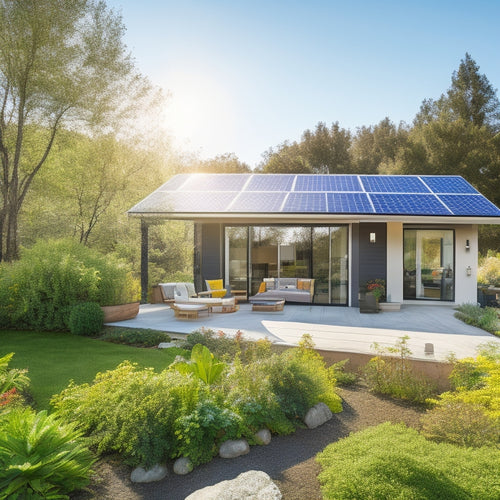
5 Essential Tips for Your DIY Home Solar System
Share
Maximizing your DIY home solar system requires a meticulous approach to guarantee efficiency, safety, and performance. First, conduct an energy audit to assess your needs accurately. Choose high-efficiency solar panels that match your energy consumption and weather conditions. Guarantee proper installation with durable mounting hardware and ideal angle alignment. Use the correct wire gauge and appropriately rated breakers for safe system wiring, and label connections for ease of troubleshooting. Finally, engage in regular monitoring and maintenance by inspecting your inverter, cleaning panels, and checking battery storage levels. Following these tips guarantees a well-performing and reliable solar setup. Discover more practical insights and technical details ahead.
Key Takeaways
- Conduct an energy audit to determine your home's baseline electricity usage.
- Choose high-efficiency solar panels that match your energy needs and available roof space.
- Ensure your roof is compatible and use durable mounting hardware for secure installation.
- Select appropriate wire gauge and breakers to ensure safe and effective system wiring.
- Regularly monitor and maintain your solar system for optimal performance and longevity.
Assess Your Energy Needs
https://www.youtube.com/watch?v=khYZTmm7S5I
Before you invest in a DIY home solar system, you need to accurately assess your household's energy consumption patterns and peak demand times. Conducting an energy audit is crucial to understand your baseline usage and identify areas for efficiency improvements. Begin by examining your electricity bills over the past year to calculate your average monthly and annual consumption. Pay attention to seasonal variations.
Next, use energy monitoring tools to track real-time usage. These devices provide granular data, allowing you to pinpoint peak demand times—usually mornings and evenings when household activity is highest. With this data, you can perform a thorough usage estimation to determine how much energy your solar system needs to generate.
Consider your household's future energy needs, as well. Will you be adding electric vehicles or expanding your home? Adjust your usage estimation accordingly. Incorporate industry-standard metrics like kilowatt-hours (kWh) to quantify your needs precisely.
This technical diligence ensures that your solar system will meet your energy liberation goals, providing you with both autonomy and sustainability. By executing a detailed and data-driven energy audit, you lay the foundation for a successful and efficient DIY solar installation.
Choose the Right Panels
Selecting the right solar panels for your DIY home solar system hinges on understanding key factors such as efficiency ratings, wattage, and temperature coefficient. Panel efficiency is vital; it determines how much sunlight your panels can convert into usable electricity. High-efficiency panels may cost more, but they generate greater power, making them ideal for limited roof space.
Weather considerations also play a significant role. Temperature coefficients indicate how well panels perform under varying temperatures. Lower coefficients mean better performance in hot weather, ensuring consistent energy output.
| Panel Type | Efficiency (%) | Temperature Coefficient (%/°C) |
|---|---|---|
| Monocrystalline | 15-22 | -0.3 to -0.5 |
| Polycrystalline | 13-16 | -0.4 to -0.6 |
| Thin-Film | 10-12 | -0.2 to -0.3 |
When evaluating wattage, consider your household's energy needs and available sunlight. Higher wattage panels produce more energy, but they might require more space. Match your panel's wattage to your energy consumption to maximize efficiency and cost-effectiveness.
Install Proper Mounting
To guarantee the stability and efficiency of your DIY home solar system, correctly installing the mounting hardware is vital. Start by evaluating your roof compatibility. Different roofing materials and structures require specific mounting hardware to ensure a secure and lasting installation. Asphalt shingles, metal roofs, and tile each have unique mounting solutions. For instance, asphalt shingle roofs typically use flashing and lag bolts, while tile roofs often need tile hooks.
Choose high-quality mounting hardware made from durable materials like stainless steel or aluminum. These materials resist corrosion, ensuring longevity and reliability. Make sure you select mounting racks that are adjustable, allowing you to optimize the angle of your solar panels for maximum sun exposure. This angle should be tailored to your geographic location to capture the most sunlight year-round.
Accurate measurements and proper spacing are essential. Use a stud finder to locate roof rafters for a more secure attachment. Pre-drill holes to prevent splitting and use weatherproof sealants to avoid leaks. Torque specifications provided by the manufacturer should be followed to avoid over-tightening, which can damage the roof.
Wire Your System Safely
Wiring your DIY home solar system safely demands meticulous attention to detail and adherence to electrical codes. Start by selecting the appropriate wire gauge, which is essential for minimizing voltage drop and ensuring efficient power transmission. Use a wire gauge chart to match the wire size with the current your system will carry. For instance, a 12-gauge wire is typically suited for 20 amps, while a 10-gauge wire can handle 30 amps.
Next, focus on breaker selection. Breakers protect your system from overloads and short circuits. Choose a breaker rated slightly above the maximum current your system will draw. For example, if your system's peak current is 25 amps, opt for a 30-amp breaker. This ensures you have a buffer without compromising safety.
When routing wires, avoid sharp bends and keep them away from heat sources. Use conduit to protect wires from physical damage and environmental factors. Label all connections clearly to facilitate troubleshooting.
Additionally, ensure that grounding is done correctly; a proper ground connection is essential for safety and system performance.
Monitor and Maintain Regularly
Regular monitoring and maintenance of your DIY home solar system promote peak performance and longevity. To maximize your system's efficiency and guarantee that it continues to deliver clean energy, you'll need to engage in routine checks and upkeep.
Here's a concise guide to help you stay on top of your solar system maintenance:
-
Inverter Maintenance: The inverter is the heart of your solar setup. Regularly inspect it for error codes and make sure it's functioning correctly. A malfunctioning inverter can greatly impact energy conversion efficiency.
-
Battery Storage: If you've incorporated battery storage into your system, keep an eye on the charge cycles and voltage levels. Ensure the batteries are in a well-ventilated, temperature-controlled environment to prolong their lifespan.
-
Panel Cleaning: Dust, debris, and bird droppings can reduce solar panel efficiency by up to 20%. Clean your panels every few months using a soft brush or a low-pressure hose.
Frequently Asked Questions
Do I Need a Permit to Install a Solar System on My Property?
Yes, you'll need to check permit requirements and undergo an inspection process. Compliance guarantees safety, grid integration, and maximizes your investment's longevity. Ignoring these can result in fines and potential removal of your solar system.
What Is the Average Lifespan of Home Solar Panels?
Imagine your solar panels as a slowly aging star. Over 25-30 years, panel efficiency decreases due to a degradation rate of about 0.5% annually. You'll still harness the sun's power, but with slightly reduced effectiveness.
Can Solar Panels Withstand Extreme Weather Conditions?
You'll find that solar panels, built with weatherproof materials, have impressive panel durability. They're engineered to withstand extreme weather conditions, including hail, heavy snow, and high winds, ensuring long-term performance and energy independence.
How Do I Determine the Optimal Angle for My Solar Panels?
To determine the most suitable angle for your solar panels, use angle calculators to adjust based on your latitude and make seasonal adjustments. This maximizes efficiency and aligns with industry standards, ensuring your system operates at peak performance year-round.
Are There Any Tax Incentives or Rebates for Installing a Solar System?
Absolutely, there are incredible tax incentives and rebates that'll blow your mind! You can achieve massive cost savings and enjoy significant environmental benefits. Check federal ITC, state rebates, and local utility programs for maximum financial liberation.
Related Posts
-

Green Home Improvements Using Solar Power
Investing in solar power alters your home into a sustainable haven while slashing energy costs. You can greatly reduc...
-

Energy-Efficient Home Upgrades for Cost Reduction
To reduce costs with energy-efficient home upgrades, focus on essential improvements like smart thermostats, energy-e...
-

Sustainable Home Design for Reduced Carbon Footprint
Sustainable home design is your pathway to a smaller carbon footprint and a healthier living space. By incorporating ...


